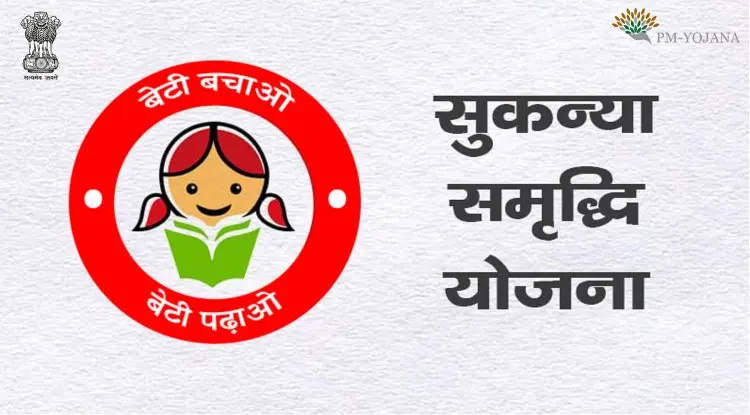Sukanya Samriddhi Scheme - Beti Bachao Beti Padhao Campaign
This scheme focuses on encouraging the parents of the female child for building a fund for their future education and marriage expenses

Sukanya Samriddhi Scheme - Beti Bachao Beti Padhao Campaign
This scheme focuses on encouraging the parents of the female child for building a fund for their future education and marriage expenses
Sukanya Samriddhi Yojana
Sukanya Samriddhi Account, abbreviated as SSA, is a savings scheme that is especially designed for the welfare of the girl child, as evident from the name. It was introduced by the Ministry of Finance and launched by the Hon’ble Prime Minister of India, Shri Narendra Modi, on 22nd January 2015, as a part of the 'Beti Bachao Beti Padhao' campaign.
The objective of Sukanya Samriddhi Yojana is to ensure the financial independence of women by encouraging them to invest in a savings scheme that would enable them to fulfil their long-term life goals and dreams like higher education, marriage, etc. and ensure financial stability. As per the FY 2018-19 AY 2019-20, the rate of interest is 8.5%, one of the best for savings schemes of this nature. This further emphasises on the benefit of investing in Sukanya Samriddhi Yojana savings scheme. Not just that, it also offers tax benefits under Section 80C of the Income Tax Act, 1961.
The Government of India has made the Sukanya Samriddhi Yojana easily accessible to people by enabling them to open an account at any post office. One can also open a Sukanya Samriddhi Yojana account at any one of its extensive list of 22 authorized banks, as discussed later in the article. The initial deposit can range between Rs. 250 and Rs. 1,50,000 annually, as per the financial objectives of the accountholder. The subsequent deposits can be made in multiples of Rs.100.
While the accountholder has to pay towards Sukanya Samriddhi Yojana savings scheme for 14 years, the investment reaches its maturity term after 21 years since the date it was issued. The government enables the flexibility of the savings scheme account to be transferred from one bank or post office to another bank or post office within India.
Features of Sukanya Samriddhi Yojana
Let take a look at the salient features of Sukanya Samriddhi Yojana savings scheme:
-
Sukanya Samriddhi Yojana saving scheme authorizes parents of the girl child or legal guardians, in the absence of parents, to open an account.
-
Parents are eligible for holding two accounts simultaneously under the Sukanya Samriddhi Yojana saving scheme for two girl child, while twins resulting in three girl child allows parents to hold a maximum of three accounts.
-
The minimum annual deposit that has to be made towards Sukanya Samriddhi Yojana is Rs. 250 with the maximum annual limit being Rs. 1,50,000. Earlier, the minimum limit was Rs. 1,000 and has been reduced to make the scheme accessible to the masses.
-
The existing interest rate, as per FY 2018-19 is 8.5%. It varies quarterly. This is among the highest for such savings schemes.
-
Accountholders can avail tax benefits under Section 80C of the Income Tax Act, 1961, on deposits made towards Sukanya Samriddhi Yojana.
-
The account can be closed prematurely on the untimely death of the accountholder.
-
At the end of the year, a payment of Rs. 50 has to be made over the minimum annual deposit towards the Sukanya Samriddhi Yojana savings scheme as a confirmation for reviving the account.
-
The minimum amount of Rs. 250 has to be paid every year to prevent the account from getting deactivated.
-
Deposits towards Sukanya Samriddhi Yojana savings scheme can be made in the form of cheque, demand draft or cash.
-
The accountholder of the Sukanya Samriddhi Yojana scheme can withdraw up to 50% of the accumulated amount after reaching 18 years of age.
-
Sukanya Samriddhi Yojana accounts mature after 21 years since the issuance of the account or on the day of her marriage, whichever is earlier.
-
After maturation of the scheme, the accountholder will be paid the accrued interest.
Benefits of Sukanya Samriddhi Yojana
Sukanya Samriddhi Yojana savings scheme offers parents or legal guardians the opportunity to financial plan the future of their girl child well in advance to secure her future and help her in reaching her ambitions. Some of the benefits that make Sukanya Samriddhi Yojana an efficient saving scheme for financially securing the future of the girl child are:
High rate of interest
The existing interest rate of 8.5%, for FY 2018-19 is one of the highest among the savings schemes of this kind. The interest rate is revised every quarter in a year. However, the rate remains the highest as compared to other savings schemes.
Tax benefits
Apart from assuring the financial security of the accountholder, Sukanya Samriddhi Yojana offers tax benefits under Section 80C of the Income Tax Act, 1961. The maximum limit of tax exemption that can be availed is Rs. 1,50,000, which is the limit applicable for all other investments that are exempted from taxes under this section of the Income Tax Act, 1961. The accrued interest throughout the tenure of the Sukanya Samriddhi Yojana savings scheme as well as the maturity amount is exempted from taxes.
Maturity benefits
On the maturity of a Sukanya Samriddhi Yojana savings scheme, the account balance that the girl child will be eligible for is the sum total of the principal amounts consistently deposited in the account and the accrued interest on this principal amount. This amount is directly payable to the accountholder, that is, the girl child for whom the account was opened. The aim of the Sukanya Yojana savings scheme is to empower the girl child in India by enabling her to achieve her ambitions and ensuring her financial independence.
Premature /partial Withdrawal
The Sukanya Samriddhi Account reaches its maturity when the accountholder reaches 21 years of age, though deposits can be made into the account for 14 years from the date of its issuance. The account ceases to exist when the girl child reaches 21 years or gets married, whichever event occurs earlier. You need to make sure that she is at least 18 years of age on the date of her marriage to be able to withdraw the balance amount from her Sukanya Samriddhi Account. However, a partial withdrawal of a maximum of 50% of the account balance can be withdrawn only for the purpose of financing her higher education.
Sukanya Samriddhi Yojana (SSY) Interest Rates
Sukanya Samriddhi Yojana’srate of interest for January to March 2019 (Q4, FY 2018-19), is 8.5%. This rate of interest on the Sukanya Samriddhi Yojana is ascertained by the government and is revised each quarter.
Sukanya Samriddhi Scheme Eligibility for the Girl child (Accountholder)
For the girl child, the eligibility criteria that needs to be met are:
- Only girl children can avail the benefits of Sukanya Samriddhi Yojana saving scheme.
- To be eligible for opening a Sukanya Samriddhi Account, the maximum age of a girl child cannot be more than 10 years. However, a grace period of 1 year is allowed. For instance, a 10 years old girl can still hold a Sukanya Samriddhi Account, provided it is opened within a year of her turning 10 years of age.
- A proof of age of the accountholder has to be submitted at the time of applying for the savings scheme.
Sukanya Samriddhi Yojana Eligibility for Parents
The eligibility criteria for parents or legal guardians to be able to open an account for their girl child are:
- Only biological parents and legal guardians for a girl child can open a Sukanya Samriddhi Account on behalf of their child.
- One parent or legal guardian can open a maximum of two accounts for their girl children.
- As discussed above, a parent or legal guardian can open one Sukanya Samriddhi Accounts for one girl child, with the maximum number of accounts that can be opened being two. In case of twins and triplets, one parent or legal guardian is eligible for opening up to three accounts.
Other details of Sukanya Samriddhi Yojana
-
No interest will be credited after the maturity period of 21 years if fund is not withdrawn
-
Multiples of 100 can be deposited in the account with a minimum of INR 1000 per year
-
Need to pay in this scheme for 14 years after opening the account, which means if the account was opened on X age of the girl then the payment needs to be made X age of the girl + 14 years
-
The interest rate since its launch is as follows: From April 1, 2014: 9.1% From April 1, 2015: 9.2% From April 1, 2016 -September 30, 2016: 8.6% From October 1, 2016-December 31, 2016: 8.5% From July 1, 2017- December 31, 2017: 8.3%
-
A passbook will be issued after the account is opened bearing the date of birth of the girl child, date of opening of the account, account number, name and address of the account holder and the amount deposited.
-
If original passbook is lost then duplicate passbook will be issued for a fee of INR 50 rupees.
-
Non-resident Indians cannot open a Sukanya Samriddhi Yojna
-
Premature closure of an SSY account can be put forward in the event of death of the account holder or on extreme compassionate grounds such as medical support in life-threatening diseases.
-
Maturity amount will be given directly to the girl child
-
Sukanya Samriddhi Yojna scheme is also available for adopted girl child
Review of Sukanya Samriddhi Yojana
Sukanya Samriddhi Yojna savings scheme is a great initiative by the government of India for the empowerment of girl child. It helps the parents and guardians to systematically save and build a corpus for growth and development of the girl’s bright future. The best thing about the scheme is it has been kept affordable for the masses and offers one of the best returns in small deposit schemes in the market. So, don’t miss out on this lucrative scheme, and give your girl child the best future she deserves, as a woman plays a key role in shaping the future of the society and the country.
-







